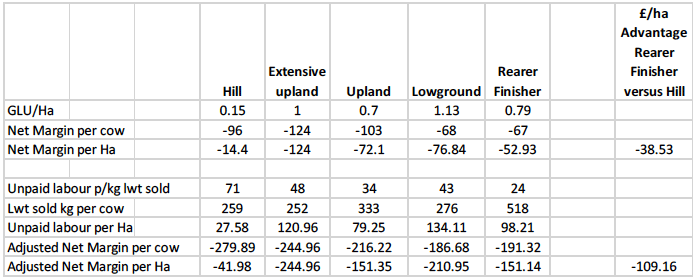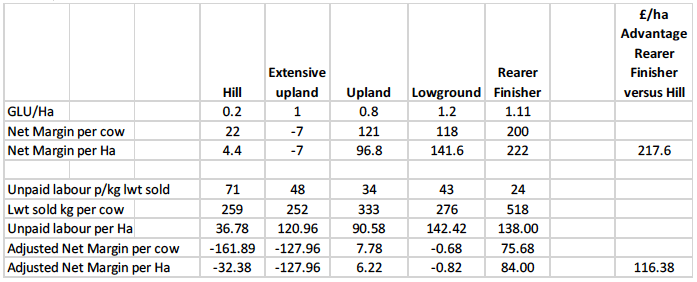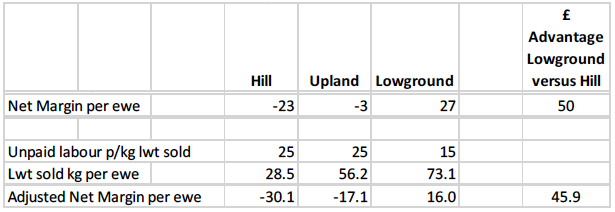Evaluation of less favoured area support scheme
Report to help inform preparations for the transition from Less Favoured Areas (LFAs) to Areas of Natural Constraint (ANCs).
6. Income Forgone and Additional Costs.
Principles
74. The prices of factors of production adjust to the level of disadvantage. Feed and fertiliser hauled in to remote areas will obviously be more expensive. However, local production factors should be cheaper. Rents are lower in Caithness than they are in Aberdeenshire, where they are in turn substantially less than in Angus or the Lothians. As a result holding size and especially farm size is much larger in hill areas than in lowground areas. This endogenous adjustment, at least to some extent, compensates for the lower output and higher costs (per unit of output) on LFA land. Labour costs are driven by demand for labour in the wider economy rather than agriculture alone, and wage rates are less in remote areas than in areas close to abundant employment opportunities such as Aberdeenshire or the Lothians (Cook et al., 2016). [14]
75. It makes no sense to compare standard systems across hill, upland and lowland - for example comparing the costs of an essentially lowground cattle system (using lots of straw and concentrates) across these three levels of land quality, and to then use this as an example of cost disadvantage. A hill producer would not sensibly operate a cattle system which needed to buy in large amounts of straw and concentrates. A hill producer acting rationally would utilise the unique resources of that situation, wintering cows at low stocking rates on a dry or sheltered hill, maximising use of home-grown silage and selling calves before they need large amounts of concentrate, using roughage- maximising breeds, selling breeding stock rather than finishing cattle, and so on. Likewise an arable farmer operating a cattle system would not put down the large areas of grass typical of upland systems, but would maximise use of arable by-products. To get at the real disadvantage suffered by LFA producers we need to get beyond simplistic comparisons, and we need to build in how rational producers would adjust.
76. We need to recognise that previous support regimes (headage payments, SFPS, building grants) have shaped current LFA systems. There is an argument that they have sometimes encouraged farmers to adopt rather standardised systems whatever their location. Grants for agricultural sheds have clearly produced many benefits, but they have also sometimes tied farmers into systems requiring lots of purchased straw, or expensive slurry handling. The requirement to boost productivity to pay for the investment and the existence of the shed to overcome harsh winters, has allowed the adoption of essentially lowground cattle breeds on hill farms. These require higher inputs. It could be argued that it is not the role of LFA support to compensate for the higher costs of what may be inappropriate systems, encouraged and supported by other subsidy regimes.
77. There will be extra costs and lower income if there is production on disadvantaged land. Following the guiding principles for the Scottish ANC scheme, the aim is maintaining and promoting sustainable farming systems. Presumably this means that calculations of income foregone and extra costs need to be applied to the sustainable level of production for different levels of disadvantaged land. Yet defining sustainable production is difficult. Stocking rates are the obvious if simplistic approach, but comparisons could also be on the basis of, for example, returns per animal, per ha, per labour unit or per £ of capital investment (the latter being how performance comparisons across other, non-farm, types of business are generally conducted).
78. Hill areas will mostly receive higher Pillar I payments under the new area-based regime being phased in to 2019. Intensive cattle and sheep farms (especially beef farms) on the better LFA areas will mostly see reduced payments. This potentially means that areas with low production levels and hence low levels of income foregone/extra costs will in effect be over compensated, and areas with high production levels and hence lots of extra costs/income foregone due to natural constraints, will in effect be under compensated. As already noted in previous sections, the effect of an LFA/ ANC payment needs to be considered jointly with whatever Pillar I payment is in place, and the relationship between different factors is unlikely to be linear or constant across different locations, farm types or enterprise scales.
Commentary on cost data provided for review
79. SRUC Farm Management Handbook ( FMHB). This publication presents typical hill, upland and lowground systems, but is not a sound basis for assessing income foregone and extra costs. Firstly, cattle and sheep margins are only presented to Gross Margin level (output minus variable costs). Much of the difference between hill and lowground may be due to fixed costs. Secondly, the margins are illustrative and not based on surveys of real businesses and their costs. For example, the lowground suckler cow margins in the FMHB are much lower than those for upland or indeed hill cow systems. This is partly due to home-grown straw in the lowground example being priced at a very high opportunity cost. In reality, the lowground farmer will view it as a by-product with only a baling and handling cost (and a useful value once "processed" into dung). A similar argument could be made about home-grown feed barley on a largely arable unit.
80. QMS Cattle and Sheep Profitability in Scotland . This presents figures based on detailed analysis of the costs and incomes of a decent sized sample of real cattle and sheep enterprises, throughout Scotland, covering all levels of disadvantage. The figures are produced to Net Margin level including rent and finance costs, but excluding unpaid family labour (who get their return as drawings from the business). However, the unpaid labour is valued and made available in the document. No area-based subsidies are included. Unfortunately, the figures are only produced as £ per head, not per hectare. Table K, below, reworks the QMS 2014 cattle enterprise margins, to include unpaid labour and, using the published Grazing Livestock Units/ha, to give an approximation of margin per hectare. More work is, however, required to get at the true margin per hectare rather than an approximation.
81. Table K covering average results, on first inspection, presents a confusing picture. All the cattle enterprises have a negative net margin. Lowground types lose a bit less than upland, as might be expected. On a per hectare basis, hill cows make the least loss - each hill cow loses a lot, but they are very lightly stocked, so the loss per ha is much lower than on intensively stocked lowland. Extensive upland is the worst place to be. Given that hill units are larger, the net loss per farm may be similar. Once we cost in unpaid labour, the pattern per hectare is the same, but loss per cow follows the pattern we might have expected with hill cows losing most (there is lower labour productivity in the hill and upland situation).
Table K: QMS Cattle Net Margins, Average Performance, per hectare adjusted for unpaid labour

82. Table L shows top third herd results. All the enterprises make positive net margins per cow and per hectare (except extensive upland which approaches break-even). Lowground enterprises make bigger margins than hill enterprises. When unpaid labour is costed in, hill and extensive upland systems with their low labour productivity, move into loss. Lowground cattle enterprises break-even and top-third rearer-finishers still make positive margins.
Table L: QMS Cattle Net Margins, Top Third Performance, per hectare adjusted for unpaid labour

83. Table L may reflect the actions of economic maximisers with an eye on a future with less subsidy support, and hence reflect true differences in levels of disadvantage. This very simple analysis suggests that the difference is around £116 per hectare between hill and lowground. The figures suggest difficult questions about the distribution of support. If the aim is to maintain production (because of its wider benefits) then the cattle margin data tends to suggest that on a per hectare basis most support is needed in the extensive uplands, lower rates in the real hill areas and least in the lowground/better upland.
84. QMS sheep net margins (Table M) show a clear pattern of margins being higher in the lowground and lower up the hill. Unfortunately, accompanying sheep stocking rate data are not reported in the publication.
Table M: QMS Sheep Net Margins, Average Performance

85. Farm Accounts Scheme Gross Margin Data . A verifiable representative sample, but not very useful if only to Gross Margin level. Individual FAS co-operators, costed to Net Profit level, would make excellent case studies to help understand the true differences between hill, upland and lowground businesses.
86. Remoteness: cost impact study. SRUC March 2015. Using Farm Management Handbook gross margins as models means that the main purchased input costs and cattle and sheep net prices are simply adjusted for an additional haulage charge. A planned survey of input price differences across Scotland was abandoned.
87. Without a comparison of fixed costs these gross margin differences only tell half the story. Labour, rents and power costs are likely to be different. Purchased feed grain prices will be higher in remote areas, but for an Orkney farmer producing his own feed grain, the cost of production is what determines his farm profit - using local opportunity costs in the margin calculation may be distorting the true level of disadvantage. Presenting the results for a Lowland Suckler enterprise or a Suckler + Finishing enterprise in the outer islands makes little sense - these systems wouldn't be operated in those areas.
88. Defining the Vulnerable Areas of Scotland. Rural Analysis Associates, August 2011 . This study has a section on Economics of Production which mainly uses the QMS Cattle and Sheep Profitability in Scotland 2010 edition figures and specifically the LFA Hill suckler and sheep net margins. There are some bold assertions that farms in the vulnerable areas will be "average" or "bottom third" and some useful figures comparing feed costs, diesel prices and hay prices across LFA areas. A costing for indoor finishing of lambs on concentrates unsurprisingly shows the extreme disadvantage of doing this in Shetland as compared to Aberdeenshire. However, as with other comparisons described earlier, it makes little sense to transpose lowground systems into hill/island areas. If extra time and financial resources were to be applied to a sheep enterprise in Shetland the first thought would surely be to how to produce a more attractive store lamb - for example through improved ewe genetics, ram genetics, targeted ewe feeding, the quality of homegrown forage - rather than shipping in concentrates to finish lambs.
Summary
89. In terms of data to get a better understanding of income foregone/extra costs, the need is for whole farm profitability data or at least enterprise net margins. Fixed costs must not be ignored. Whole farm profit data also accounts for differences in scale between hill, upland and lowground. Farm income and indeed farm household income is surely the critical measure. [15]
90. There is a very strong need for case studies on real farm businesses. It would be useful to have aggregate data which provided neat answers to the geographic distribution of income foregone/extra costs, but the range of available data do not provide such insights. Case studies on real businesses from across the islands, remote mainland, better upland and lowground would help develop the understanding of what is really different for a remote business. The physical and financial position of each case farm needs to be described, including all the external support and the intensity and mix of different inputs. Different systems may have different cost structures, but (reflecting the principle of equi-marginal returns) profitability may be more similar if expressed in terms of net (rather than gross) margins and if consideration is given to different denominators. For example, per animal, per ha, per labour unit or per £ of capital investment
91. In looking at financial disadvantage, unpaid family labour should not in our view be ignored. Much of the real difference between hill and lowground units is in labour productivity - more labour input is needed to produce each unit of output. This is partly due to the need to spread stock over very large areas of difficult to access terrain, increasing the time required to feed, gather, treat and generally manage. Shorter growing seasons and poorer quality forage mean less liveweight growth per fixed unit of labour.
92. In our view it would be wrong to base support on income foregone/extra cost calculations which are based on theoretically transposing lowground systems on upland and hill situations rather than on genuine baselines and counterfactuals. Also there is a question over support for extra costs due to the adoption of systems, which were driven by previous support and grant regimes, which are now inappropriate. There is a need to look at the Top Third performers and to how systems will operate in the future, making the best use of local resources and limitations. This forward looking approach should extend to how the new BPS regime will redistribute Pillar I payments.
93. If the aim is to sustain production levels, the ranking of disadvantage may be extensive upland first, hill second, better upland third. The income foregone/extra costs don't just increase with remoteness and declining production conditions, but also with the level of actual production. The question of course would be if the level of production on the extensive upland is sustainable and therefore compatible with the ANC scheme.
94. However, sustainability has different aspects and the endogeneity of production systems includes responses to support payments such that the degree of reliance on support is not necessarily linked inversely to land quality. For example, livestock enterprises on better quality land typically use capital and labour more intensively. Consequently, reductions in support levels for better quality land may lead to more significant management changes there than increases in support levels induce on poorer quality land. For example, farms on better quality land may respond to declining support by running stock more extensively and reducing labour usage. Whether this leads to improved sustainability will depend on local circumstances in terms of, for example, environmental pressures and opportunities for non-farm employment.
95. An alternative approach to calculating appropriate payment rates would be to estimate the external funding needed to provide sufficient income to a farm household. This would not require comparison with the production characteristics of non- LFA farms per se but rather with some target level of acceptable family income. As such, this would avoid issues of competitiveness or business viability by explicitly accounting for rising incomes across the economy in general, but would also imply a (public good) policy objective related to rural incomes or population retention rather than commodity production.
96. However, such a "needs-based" approach would also encounter practical difficulties. For example, farm households vary greatly in composition (e.g. size, age profile) and ability to generate income from on- and/or off-farm sources. Considering individual circumstances would be administratively costly (and the implied means-testing would be contentious) but offering standard support rates would lead to overly generous support to some and inadequate support to other households. It would also raise issues of why income support was being offered to households with high net worth (i.e. land wealth).
97. This suggests that payments would be better justified in terms of promoting positive outcomes rather than negative constraints and defining payment levels on the basis of total management costs rather than by reference to additional cost relative to some artificial comparator. However, such alternative approaches are not permitted under the RDR, meaning that any payments under ANCs can only be based on additional costs and income foregone arising from biophysical constraints - which is a critical limitation.
Contact
Email: Eilidh Totten
There is a problem
Thanks for your feedback